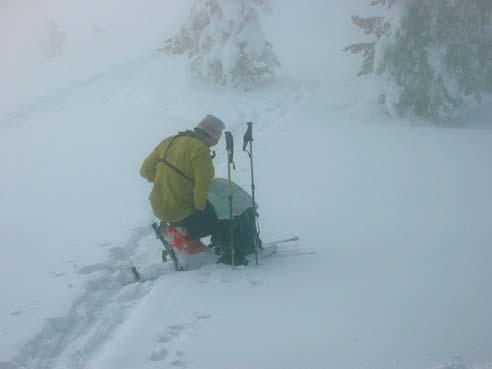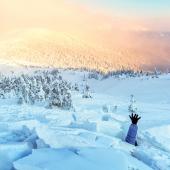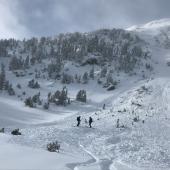Safe Ground
My partner and I ski across a slope covered with avalanche debris. It looks to be a couple of days old, but the crownline at the top of the slope is obscured by storm clouds and I try to convince myself that it will not slide again. We both understand this and keep a healthy amount of space between us as we skin along.
We have come to see an avalanche that nearly buried a friend of ours. The thick band of clouds that sags over the ridgeline and hinders our visibility also challenges our route-finding skills. It is snowing much harder than when we set out, and my face stings from the wind. “We have to cross these gullies to see the slide that caught him,” Ron yells into the wind.
From a clump of trees perched on the crest of a rib we survey the terrain features around us. Above, all we can see is swirling snow and milky skies. We anxiously poke at the snow with our ski poles, trying to read the layers within the snowpack.
“Spot me from here, I'll head across.” Ron doesn’t actually say this, but points to me, then to my eyes, then to him, then the slopes. A grin crosses my face, and for a moment I think I am on some sort of SWAT mission. Actually, this is just another day in the backcountry with my friend Ron Johnson, a forecaster with the Gallatin National Forest Avalanche Center.
I can see that his mind is racing as he adjusts his goggles. New snow. High winds. Recent avalanches. Low visibility. He is adding up the equation but already knows the answer: we shouldn’t be here.
Gingerly, he pushes off the small rib that we believe is relatively safe. Before he reaches the gut of the slope he looks up and to his right: nothing but the same flat, white light. Then he looks down and to his left: a narrow gully, some rocks, a drop-off, several small trees. Ouch! Bad run-out. Then he looks back at me. Through his goggles his eyes plead, “Watch me, man."
With determined shuffles he puts one ski in front of the other and continues across. About 25 feet out he slows to a crawl. Suddenly his back arches like a Halloween cat and he appears to be standing on his tippy toes. There was no visible flash but you could feel something—a jolt from the snow. And then, a loud WHOOMPF! This is the sign that the natural balance within snowpack is tipping in a direction that favors neither of us. This unmistakeable sign is possibly the scariest sound you will ever hear in the backcountry. The pucker factor is instantaneous.
The message comes up through the snow and into his skis, through his boots, and out through the hair on the back of his neck. The snowpack is trying to tell us something. Actually, it is screaming at us. Again, he looks up to his right, down to his left, and finally back at me. I hear a strange thumping in my ears and realize that I have been holding my breath.
He mumbles, “I’m outta here,” and throws a kick turn. Before I know it, he is standing next to me. Without another word we rip off our skins and prepare to turn around. We ski one at a time, watch each other and take care. Further down, we ski over some fresh avalanche debris. It is a warning not to let our guards down. Soon we are down into an area of thick, protected trees on flat ground. Safe ground. The tension of the situation begins to lift.
On the way out, I realize that I have learned something about avalanches today, but I can’t quite put my finger on it. To shed some light I ask Ron, "So, to be an avalanche expert, you really just have to know when to turn around?"
He thinks a minute then says, “You know, there’s an old saying that an avalanche doesn’t really care if you are an expert.”
I ponder this and trudge on. The daylight is fading quickly and we are a long way from the road, so we keep moving. In silence we kick, glide, and skate through the fresh snow. Our minds wander in different directions as we travel the same way and I file his words for future reference.
A Dozen More Turns
Amber Seyler’s documentary film A Dozen More Turns: An Avalanche on Mt. Nemesis, about a backcountry ski trip in the Centennial Mountains gone terribly wrong, should be required viewing for every backcountry enthusiast. We’ve all seen the avalanche reports, we’ve heard about skiers and snowmobilers getting buried—and occasionally even dying—but it always seems a little distant, a bit beyond our own worlds. A Dozen More Turns changes all that. Poignant interviews with Sam Kavanagh, who barely escaped with his life (his friend, Blake Morstad, did not), and local avalanche forecaster Doug Chabot bring to life the horrific details of that fateful New Year’s day in 2005, when a group of experienced backcountry skiers made a single mistake and lost a friend forever. For more information or to obtain a copy, visit amberseyler.com or mtavalanche.com.
-Mike England












